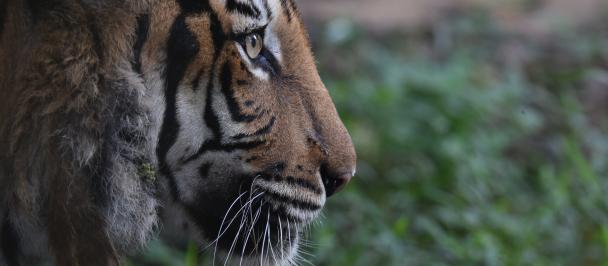A World Without Durians Is No Place for Me
May 21, 2024

A market stand selling a variety of Durian fruits at night in Kuala Lumpur, Malaysia.
No Malaysian can imagine a world without durians, which rely on fruit bats for their pollination. Similarly inconceivable would be a world without laksa and sambal, whose main ingredients are shrimps and prawns that use mangroves as their nursery to grow. The connection is clear - every species is interwoven into a supportive web of other species. Nature abhors a vacuum; we cannot live in isolation. We are all connected; we are biological diversity. Because we are all part of the planet, we must all be part of the plan.
During the 1992 Rio Earth Summit, the global call for action to conserve and sustainably use biological diversity was first mooted. But three decades later, the world’s biodiversity continues to degrade. The stock of natural capital per person has declined by nearly 40%, and we are losing almost 200 species a day; up to 1 million more species are threatened. It is clear that dramatic actions are needed to change course. On 19th December 2022, world leaders reached consensus via a landmark decision to adopt a worldwide target to halt biodiversity loss through a framework known as the Kunming-Montreal Global Biodiversity Framework (KMGBF). This framework, also known as the Biodiversity Plan, has four overarching Goals with 23 global targets, all set to be achieved by 2030.
Gandhi once said, “Be the change that you wish to see in the world”. With the KMGBF, we now have a plan for this change. The responsibility is shared, and the effort is collective. Many countries have now developed their own national plans aligning to the Biodiversity Plan with local context and considering national circumstances. Malaysia is rightfully proud to note that it has made significant progress in developing and subsequently implementing the plan. Malaysia's very own, newly revised National Policy on Biological Diversity 2025 – 2030 (NPBD) was launched in October 2023 by the Minister of Natural Resources and Environmental Sustainability (NRES). The NPBD spells out five overarching Goals with 17 Targets to be achieved by 2030 through 61 actions covering various sectors.
With NPBD as the guiding document, NRES is going further by establishing a dedicated unit called the Biodiversity Implementation Support (BIS) unit. With support from UNDP through the GEF-funded GBF-EAS project, the BIS Unit initiative began its work in December 2023. The team will be the driving force in the implementation of the NPBD by undertaking coordinating tasks, mainstreaming the Plan, fostering collaboration, and providing support to various stakeholders from state government, civil society, academic institutions and the private sector. The Sarawak government has taken a bold, progressive approach for biodiversity protection within its jurisdiction. In partnership with UNDP, the Ministry of Natural Resources and Urban Development Sarawak (MUDeNR) has formulated the Sarawak Biodiversity Master Plan with a focus on mainstreaming biodiversity into the development agenda. While the approach is non-target based, the eventual outcomes are aligned to the Biodiversity Plan, national policy, and more importantly - it is part of the three key pillars (economic growth, social inclusivity and environmental sustainability) of Sarawak's Post COVID-19 Development Strategy 2030 (PCDS 2030). The Master Plan consists of six thematic areas cutting across different sectors, as biodiversity management is a shared responsibility at every level of government. Sarawak is an exemplar of being part of the Plan, through their initiative of formulating a master plan at the sub-national government level.
Because conserving and managing biodiversity is a shared responsibility and collective effort, successes go beyond just government, whether national, regional or local. In the realm of biodiversity conservation, civil society and non-governmental organizations are long-term partners. CBOs and NGOs need support that complements the work that they do, in the form of funding and financial support to ensure these efforts can be scaled, replicated and sustainable to compete with the rate and scale of biodiversity loss.
The biodiversity finance gap is estimated at US$700 billion per year. To close this gap, we must redirect global finance flows from nature-negative investments to nature-positive ones. This means investment and finance must be channelled to support protection, restoration and activities that are supportive of biodiversity. This includes reducing harmful subsidies while increasing incentives for protection activities. This leads us to the role of private sector, be it large corporations or Micro, Small and Medium Enterprises (MSMEs). Some private sector firms have moved forward with innovative financial schemes such as green and blue bonds, as evidenced by successful initiatives in Indonesia and the Philippines. Malaysia is following suit with the recent announcement of Biodiversity Sukuk and Tiger Bonds. The Malaysian government has taken a lead on this issue by continuing its Ecological Fiscal Transfer scheme, a concept conceived in partnership with UNDP through the BIOFIN initiative. A total of $124 million has been transferred since 2019 to incentivize state governments to protect local biodiversity. While these investments are insufficient to close the biodiversity finance gap on their own, they do represent a step in the right direction as part of the Plan.
So, the next time we feast on national treasures like durian, laksa or sambal, let’s not forget that we all have a role to play in preserving the biodiversity that makes these treasured foods possible. Let’s be part of the Plan. Because if it not us, who? If it not now, when?

 Locations
Locations




